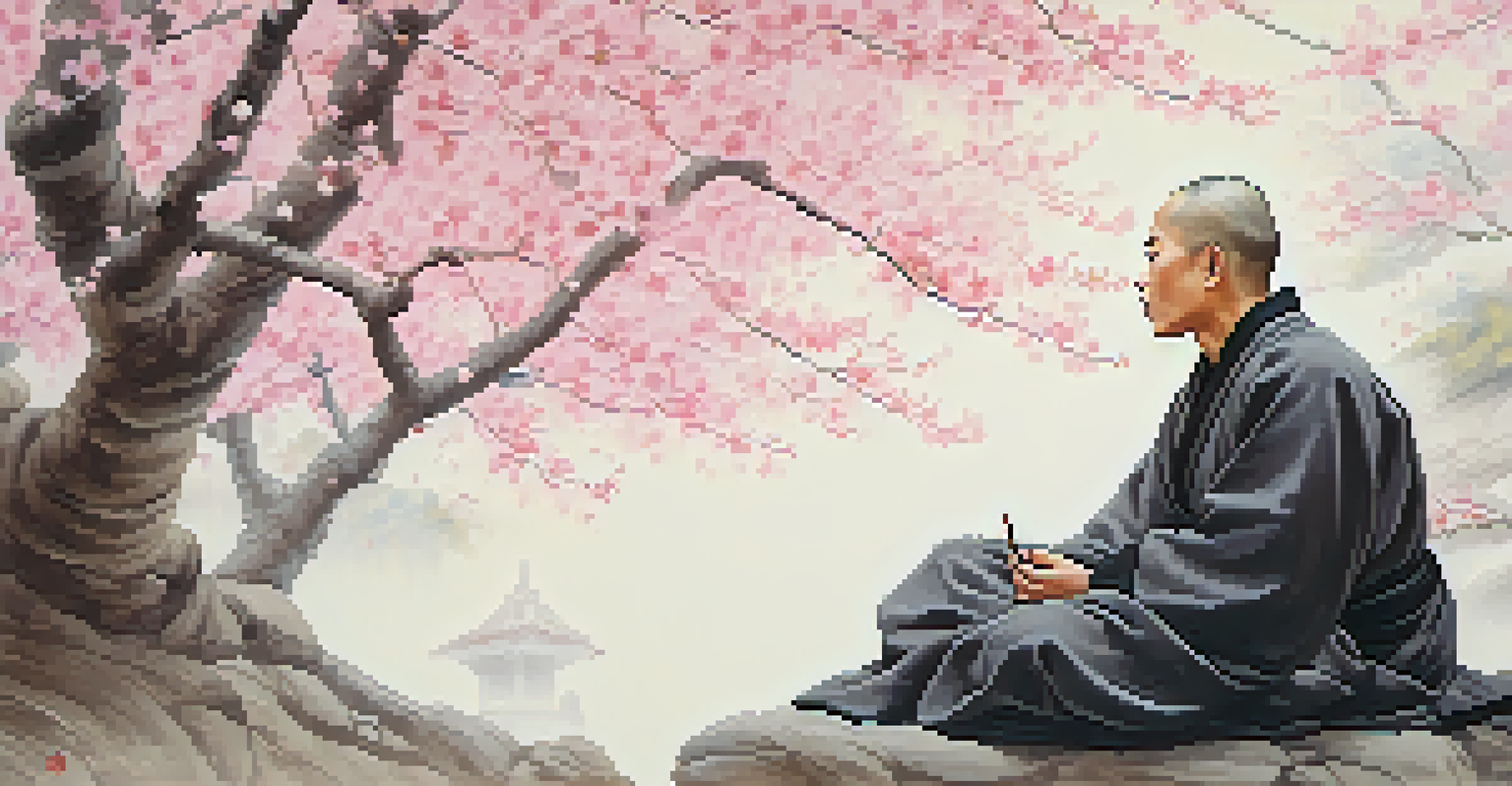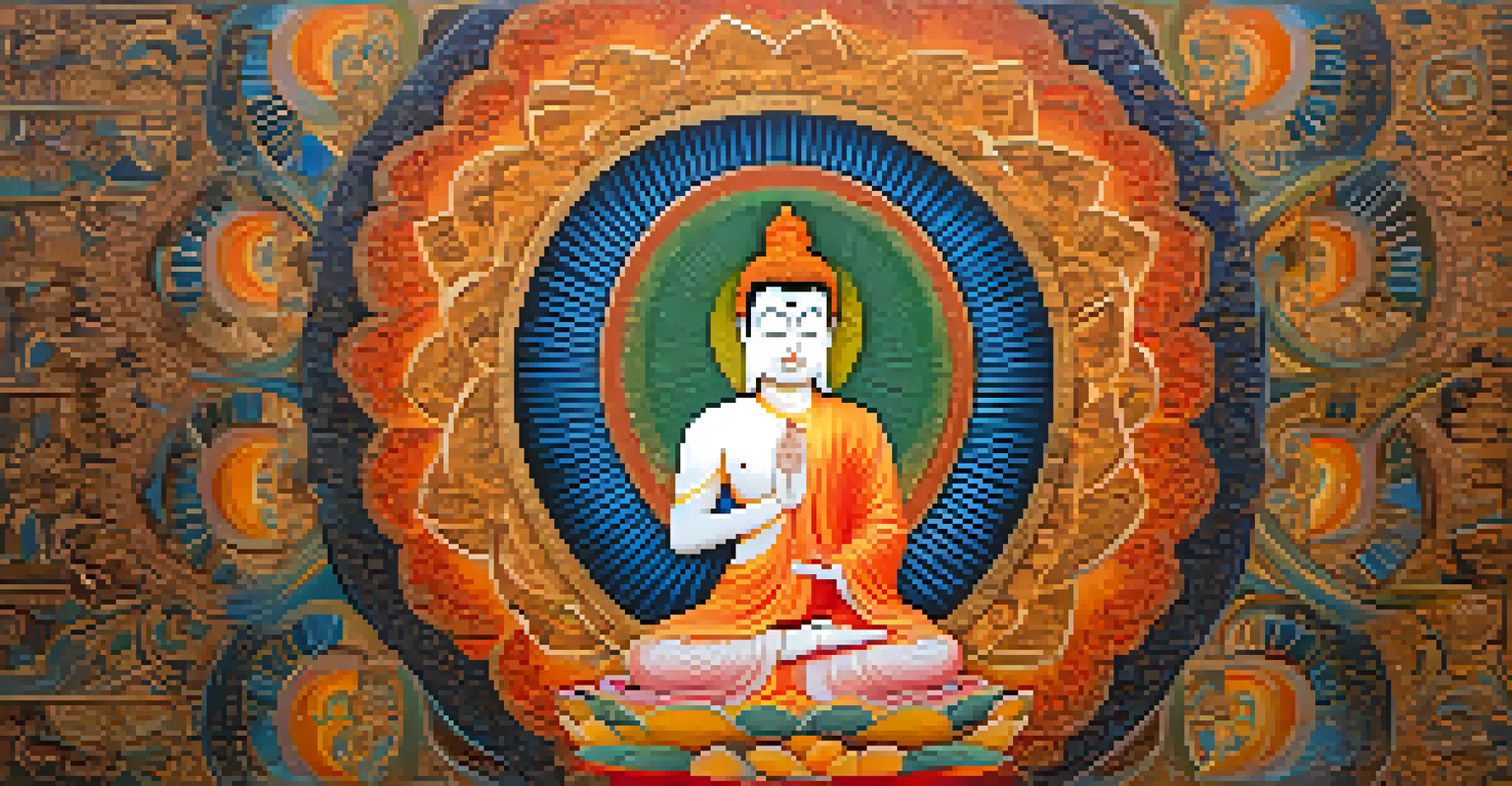The Influence of Buddhism on Asian Painting Narratives

Understanding Buddhism's Core Principles and Values
Buddhism is built on fundamental principles like the Four Noble Truths and the Eightfold Path, emphasizing suffering and its alleviation. These concepts have deeply influenced not only spiritual practices but also artistic expressions throughout Asia. Artists often depict themes of enlightenment, mindfulness, and the impermanence of life, reflecting Buddhist teachings.
Art is a reflection of the world we live in, and it can be a powerful conduit for spiritual expression.
For example, the idea of 'Anicca' or impermanence is a recurring theme in many paintings. Artists capture fleeting moments in nature, illustrating the beauty and transience of life. This approach encourages viewers to appreciate the present, a core tenet of Buddhist thought.
Moreover, the representation of Buddhist figures, such as the Buddha or bodhisattvas, serves to convey these teachings visually. Each artwork becomes a narrative that invites contemplation, allowing viewers to engage with these profound ideas.
The Role of Meditation in Artistic Creation
Meditation is central to Buddhist practice, promoting mindfulness and clarity of thought. Many Asian artists incorporate this meditative state into their creative process, leading to artwork that resonates with tranquility and depth. This aspect of creation transforms each piece into a form of meditation itself.

For instance, the meticulous brushwork seen in traditional Chinese ink painting often reflects the artist's meditative state. Each stroke is intentional, symbolizing the artist's focus and connection to the moment. This practice not only enhances the artwork but also embodies the essence of mindfulness.
Buddhism Shapes Artistic Expression
Buddhism's core principles, such as the Four Noble Truths, deeply influence artistic themes, encouraging representations of enlightenment and the impermanence of life.
As a result, these paintings often evoke a sense of peace, drawing viewers into a contemplative experience. This connection between meditation and art emphasizes the transformative power of both practices, reinforcing their intertwined nature.
Symbolism in Asian Painting: A Buddhist Perspective
Symbolism plays a crucial role in Asian painting, particularly with Buddhist influences. Common symbols like lotus flowers, which represent purity and enlightenment, are often depicted in various artworks. These symbols convey deeper meanings, inviting viewers to reflect on their spiritual journey.
Meditation is not a means to an end. It is both the means and the end.
The use of color also carries significant symbolic weight in Buddhist art. For example, the color gold symbolizes enlightenment and divine presence, while blue often represents compassion and wisdom. Artists skillfully use these colors to enhance the narrative and emotional impact of their work.
This rich tapestry of symbolism creates layers of meaning in each painting, encouraging viewers to explore beyond the surface. Through this lens, the artwork becomes a visual narrative that communicates Buddhist principles in an engaging and thought-provoking manner.
Cultural Exchange: Buddhism's Impact Across Asia
Buddhism's spread across Asia has led to a fascinating exchange of artistic ideas and styles. As Buddhism traveled from India to China, Japan, and other regions, it adapted to local cultures, creating unique artistic expressions. This blending of influences enriches the narrative traditions found in Asian painting.
For instance, the transition from Indian art's narrative reliefs to the serene landscapes of Chinese painting illustrates this cultural adaptation. While the themes remain rooted in Buddhism, the artistic techniques and styles reflect local traditions and philosophies.
Meditation Enhances Artistic Process
Many Asian artists incorporate meditation into their creative processes, resulting in artwork that embodies tranquility and mindfulness.
This cultural exchange not only diversified artistic practices but also fostered a deeper understanding of Buddhism itself. As artists absorbed and reinterpreted these influences, they created a vibrant dialogue between cultures, enhancing the narrative depth of Asian painting.
Buddhist Iconography in Paintings: A Visual Language
Buddhist iconography serves as a visual language, rich with meaning and history. Each figure, gesture, and object depicted in paintings carries specific significance, conveying teachings and stories from the Buddhist tradition. This iconography helps narrate complex spiritual concepts in an accessible way.
For example, the gesture of 'abhaya mudra,' or fearlessness, is often depicted in paintings of the Buddha, symbolizing protection and reassurance. Such representations allow viewers to connect emotionally with the teachings, making the messages more relatable and impactful.
This visual language transcends cultural barriers, allowing individuals from different backgrounds to engage with Buddhist narratives. As a result, the artwork becomes a bridge, fostering understanding and appreciation for Buddhist philosophy across diverse audiences.
The Evolution of Buddhist Art Through Time
Buddhist art has evolved significantly over the centuries, adapting to changing cultural and social landscapes. From ancient cave paintings to contemporary installations, each phase reflects the values and beliefs of its time. This evolution showcases how Buddhism continues to inspire and innovate within the realm of art.
In the early days, art was primarily focused on religious themes, often serving as a tool for teaching. As societies progressed, artists began to explore more personal interpretations of Buddhist concepts, integrating modern techniques and materials. This shift allowed for a broader range of expressions and narratives.
Symbolism Deepens Artistic Narratives
Buddhist symbolism in art, such as lotus flowers and specific colors, enriches the artwork's meaning, inviting viewers to explore deeper spiritual concepts.
Today, contemporary artists draw on traditional Buddhist themes while experimenting with new forms, including digital media and mixed materials. This blend of old and new highlights the ongoing relevance of Buddhism in the art world, illustrating how its narratives continue to resonate in today's society.
The Impact of Buddhism on Contemporary Asian Artists
Contemporary Asian artists draw inspiration from Buddhism, infusing its principles into their work while addressing modern themes. This connection to tradition allows them to create pieces that reflect both personal and collective experiences, bridging the past with the present. Artists often reinterpret ancient symbols and narratives to make them relevant to today's audience.
For example, some artists use traditional Buddhist motifs to explore contemporary issues such as identity and environmentalism. This fusion of old and new enables a dialogue between generations, encouraging viewers to reflect on their own values and beliefs.

As these artists navigate the complexities of modern life, their work often serves as a reminder of Buddhism's enduring wisdom. Through their creativity, they invite audiences to engage with profound themes, ensuring that Buddhist narratives remain alive and relevant in contemporary discourse.